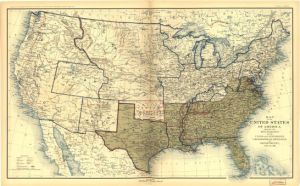 Sam Richards, an Atlanta businessman and Southern Baptist who fled the city for New York following Sherman’s capture of the city, today arrives back in Atlanta. Like many other middle class white Southerners (of whom there are relatively few, actually) who did not serve during the war, whether having temporarily lived in the North or not, Richards hopes to be able to support his family in the post-war, post-slavery South.
Sam Richards, an Atlanta businessman and Southern Baptist who fled the city for New York following Sherman’s capture of the city, today arrives back in Atlanta. Like many other middle class white Southerners (of whom there are relatively few, actually) who did not serve during the war, whether having temporarily lived in the North or not, Richards hopes to be able to support his family in the post-war, post-slavery South.
In Tyler, Texas, meanwhile, Robert Cummins Fulgham (1817-1893), a Primitive Baptist minister, slaveowner, farmer and land speculator who had served in a home guard during the war, is replaced as chief justice of Tyler County. His replacement is Andrew J. Hamilton, the provisional governor of Tyler. Fulgham is returned to office as chief judge in June 1866, only to be disqualified during Reconstruction and replaced, again, by Hamilton. Fulgham, in short, as a politically-active, anti-black white in post-war Texas, finds life difficult during the Reconstruction years.
And in Virginia, Civil War veteran John Robert Wilkinson (1842-1912), now trying to make a living farming, today professes “faith in Christ” at Goochland Baptist Church under the preaching of war-time missionary A. E. Dickinson. Four years later Wilkinson surrenders to a call to the ministry, and in the decades following pastors a number of Baptist churches in Virginia. Neither middle-class nor politically-involved, Wilkinson makes his mark in life as a shepherd of spiritual souls.
Three post-war stories of white Baptists of the South, each different in composition and character, offer glimpses into diverse paths trod by the region’s Baptists.
Sources: Sam Richards’s Civil War Diary, August 24, 1865 (link); “Fulgham, Robert Cummins,” Texas State Historical Association (link); George Braxton Taylor, Virginia Baptist Preachers, Fifth Series, 1902-1914, Lynchburg: J. P. Bell, 1915, pp. 332-333 (link)


